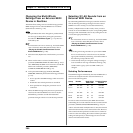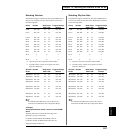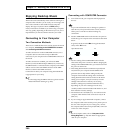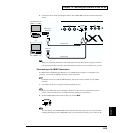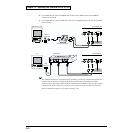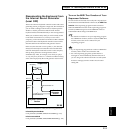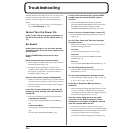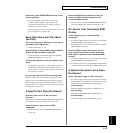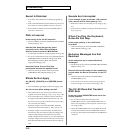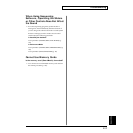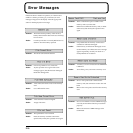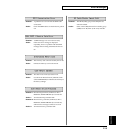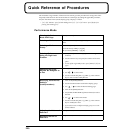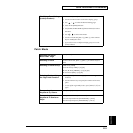
214
Troubleshooting
If the this unit does not function in the way you expect, first
check the following points. If this does not resolve the
problem, consult your dealer or a nearby Roland Service
Station.
* If a message appears during operation, consult the following
section “Error Messages” (p. 218).
Cannot Turn the Power On
Is the XV-88’s AC cord properly connected to
the AC outlet and the XV-88? (Quick Start; p.
16)
No Sound
Is the power turned on for the other devices
connected to the this unit? Is the volume level
turned down?
Is the VOLUME slider turned all the way
down?
Have connections been made correctly?
• When using the XV-88 by itself, connect audio cables or
headphones (Quick Start; p. 16).
• If using the XV-88 connected to a computer, use a
computer cable or MIDI cable to make the connection to
the computer (p. 208). Then, connect audio cables or
headphones (Quick Start; p. 16).
Can you hear sound through headphones?
• If there is sound in the headphones, it is possible that the
connection cables are broken, or that the amp or mixer is
malfunctioning. Check the connection cables and other
devices once again.
If you do not hear sound when you play the
keyboard, check whether the Local Switch is
turned OFF.
• Turn the Local Switch on by the following parameter.
In Patch/Rhythm Set Mode
Local parameter (SYSTEM/MIDI/PATCH MIDI) (p.
170)
In Performance Mode
Local parameter (SYSTEM/MIDI/PERFORM MIDI) (p.
169)
Local parameter (ZONE/MIDI/MIDI) (p. 60)
In Layer Performance mode, does the MIDI
transmit channel match the MIDI receive
channel?
• Check that the MIDI transmit channel (Channel
parameter (ZONE/MIDI/MIDI)) of the Zone matches
the MIDI receive channel (Channel parameter
(PERFORM/MIDI/MIDI)) of the Part (p. 52, p. 59).
Have all tones in the patch been turned off?
• Press TONE SWITCH [1]–[4], getting the indicators to
light (p. 32).
Are the Tone, Patch and Part level settings
excessively low?
• Check the level settings of each Tone, Patch and Part
with the following parameters.
Tone level
Level parameter (PATCH/TVA/TVA) (p. 90)
Patch level
Level parameter (PATCH/COMMON/PATCH
LVL&PAN) (p. 70)
Part level
Level parameter (PERFORM/PART/SETTING) (p. 53)
Are the effect settings correct?
• Check the Effect settings ON or OFF (p. 105), in the
Effect Balance or Level.
Are the output destination settings correct?
• Check the Output Assign settings (p. 108, p. 109, p. 113,
p. 116, p. 158, p. 160, p. 194, p. 195).
Is the Wave Expansion Board properly
installed?
• When selecting the settings that stipulate the use of XP-
A–D waves, Patches, or Rhythm Sets, check that the
specified Wave Expansion Board is installed properly in
the specified slot (Quick Start; p. 4, p. 10).
Has the volume been lowered by pedal
operations or by MIDI messages (volume
messages or expression messages) received
from an external MIDI device?
• Use the Panic function to raise the volume (p. 48).
• If you are in Performance mode, access the INFO display
(PERFORM/INFO) to check the settings of the Volume
message (Vol) and Expression message (Exp)
parameters, and make the appropriate settings (p. 56).



